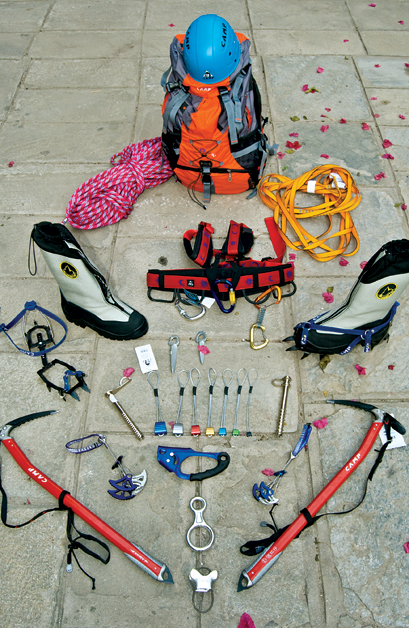When Chandra Ale, founder and director of Initiative Outdoor,offered to give us a first hand demonstration of the gear used in mountaineering, we instantly agreed to join him at the climbing site on Nagarjun Hill in Balaju. “It’s safer and easier climbing than walking to the top,” shouted a foreigner who was there for climbing practice, as we tugged behind Chandra  who wanted to show us how the main anchor was placed on the top.
who wanted to show us how the main anchor was placed on the top.
“What he essentially means is that the gear and equipment have reduced the risks involved in climbing, and mountaineering, to a bare minimum,” says Chandra, already on the top, while we struggled to hold on climbing the near vertical cliff. “If the rope being used breaks during a climb, the fate of its maker is doomed. If any of the gear fails, excluding in the cases of human errors, the company fails,” he says without mincing words. He then cautions us on why it is important to avoid using cheap alternatives. “There is no standard gear set to recommend. Mountaineers carry stuff according to their needs and depending where and how far they want to go. It is best to go with the best.”
Depending on the remoteness and the technical rigors of the site, a day of climbing can start in the early hours. Route evaluation and planning, and identifying proper equipment, are very important before proceeding. Before entering the alpine zone one should be sure to wear down pants and a down jacket of tested quality. “A rain jacket and rain pants are equally important because they protect the down clothing from getting wet. If the down outfit gets wet it is useless,” says Chandra. “To protect fingers against frost bite, mountaineers wear gloves with thick inners and water proof boots with warm socks. Gaiters, used to seal the gloves and boots, double up as a cover against frost bite.”
Once at the base of the climbing site all the gear comes into play. Every mountaineer covers his head with a helmet to protect it from objective hazards such as ice and rock fall. Next comes the harness, which in addition to the helmet is a universal piece of equipment utilized during rock and ice climbing, and in mountaineering. The front loops of the harness once on, with leg and waist loops fastened, serve as a tie in point for the leading and following climbers’ rope. This also serves as a point of rappel for the descent later on. “Before I send my clients off to the rocks, I make sure that the harness is just tight enough and is placed slightly above the hips,” says Chandra. “If you are tied well into the harness, you are safe no matter how high you go.”
The lead climbers place temporary anchors along the way using quick draws and locks as they go about finding the route. It’s up to them to search for an adequate placement of cams and stoppers in natural crevices and cracks in the rock or to figure out a proper spot on ice for placing an ice screw. Ice screws are placed in thick, suitable ice as a safety precaution for climbers making upward progress. Leading a climb is an undertaking of great risk and consequence. It includes the responsibility of route finding, the placement of protections, the management of the elements, understanding and appreciating the difficulty of the physical terrain, as well as of one’s own physical condition.
Below, the belayer manages the amount of rope fed to the lead climber and in the event of a fall locks off the rope by bringing it close to his body, instantly arresting the fall. The standard gear used for a belay is called a ‘figure eight’ (it is in the shape of an ‘8’). As our instructor was explaining the role of a belayer, we saw one of the climbers, who amazed everyone with his stamina and skill, slip off the rocks and fall head over heels. The belayer just managed to hold him on before he hit the bottom. Chandra winked at us and smiled as if to say: “You see?”
C J Carter is from Bozeman, Montana, USA. He was involved in the 2008 Khumbu Climbing School program.











